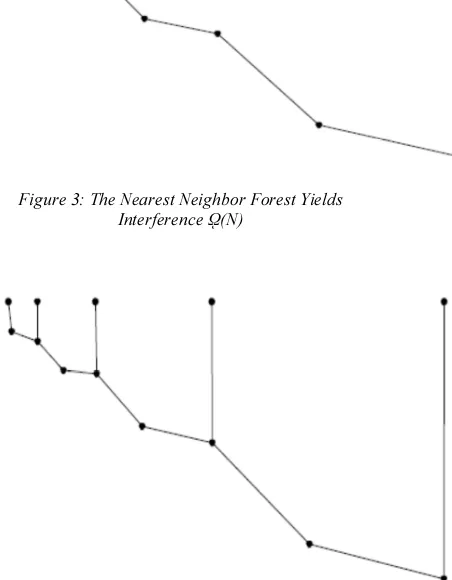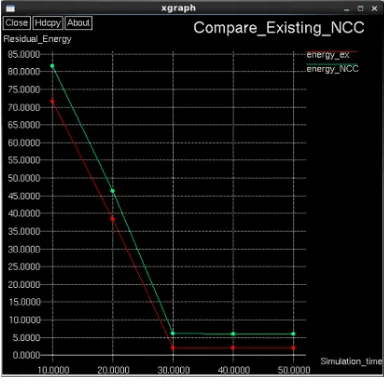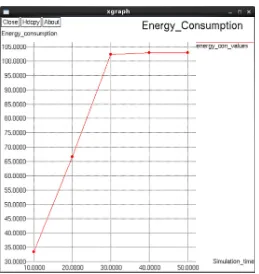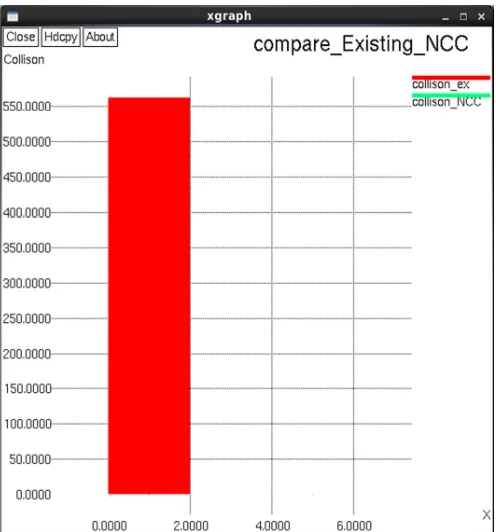ISSN: www.jatit.org E-ISSN:
SAVING ENERGY IN WIRELESS AD HOC NETWORK WITH
NEAREST COMPONENT CONNECTOR ALGORITHM
1S.K. MANJU BARGAVI, 2Dr. G. P. RAJAMANI
1
Anna University of Technology, Coimbatore, Tamil nadu, India.
2
Principal, King College of Technology, Namakkal Tamil nadu, India.
E-mail :1cloudbargavi@gmail.com
ABSTRACT
Wireless ad hoc networks generate many challenging research problems as they basically have many special characteristics and some inevitable limitations, compared with other wired or wireless networks. An important requirement of these networks is that they should be self-organizing, that is, transmission ranges and data paths are dynamically modernized with changing topology. Energy conservation and network performance are probably the most critical issues in ad hoc wireless networks, because wireless devices are usually powered only by batteries and have limited computing capability and memory. In this paper we introduce an enhanced receiver centric interference model protocol with Nearest Component Connector algorithm to calculate the energy levels in wireless ad hoc networks. The new protocol guarantees to build a valid topology for transfer data from Source to Destination. Simulation and experimental results are combined to show that collision-free and energy consumption by the new model.
Keywords: Battery, Collision, Component Connector, Energy, Topology.
1. INTRODUCTION
A wireless ad hoc network is formed by a group of wireless hosts, without the use of any infrastructure. To enable communication, hosts cooperate among themselves to forward packets on behalf of each other. The infrastructure networks have fixed and wired gateways or the fixed base stations which are connected to other base stations through wires. A 'Hand-ff' occurs as mobile host travels out of range of one base station and into the range of another and thus, mobile hose is able to continue communication seamlessly throughout the network. Example applications of this type include wireless local area networks and mobile phone.
The other type of wireless network, infrastructureless networks, is known as wireless ad hoc networks. These networks have no fixed routers, every node could be router. All nodes are capable of movement and can be connected dynamically in arbitrary manner. The responsibilities for organizing and controlling the network are distributed among the terminals themselves.
Ad hoc network nodes must conserve energy as they mostly rely on batteries for their power source. More specifically, the network that we consider has the following key characteristics:
• Transmitter locations are a realization of a
homogeneous spatial Poisson process.
• Each transmitter communicates with a
single receiver i.e. a distance d meters away.
• All transmissions occur at power p and rate
R bits/sec.
• Each receiver treats multi-user interference
as noise.
Without an inherent infrastructure, the mobiles handle the necessary control and networking tasks by themselves, generally through the use of distributed control algorithms. Ad hoc wireless networks are highly appealing for many reasons. They can be rapidly deployed and reconfigured. In this paper we present the ERCIM model that works with nearest component connector algorithm features all the relevant properties of energy consumption while being better than any previous proposals.
[1] RELATIVE MODEL AND
TERMINILOGY
A wireless network consists of a set V of
two-ISSN: www.jatit.org E-ISSN:
dimensional space. We assume that all nodes have distinctive identities and each wireless node knows its position information, for example, through a low-power Global Position System (GPS) receiver or by other means. The nodes communicate through omnidirectional antennas, which means that, when a node is using enough power to transmit over a distance d, the transmission can be received by any node that is not distant from the sender by more than
d. Each node adjusts its transmission power to the minimal value needed in order to reach the receiver.
The concept of topology control is to reduce node power consumption in order to extend network lifetime. Since the energy required to transmit a message increases at least quadratic ally with distance, it makes sense to replace a long link by a sequence of short links. As Fig. 1. topology control can therefore be considered a trade-off between energy conservation and interference reduction on the one hand and connectivity on the other hand [4].
Figure 1: Topology Control Constitutes A Trade-Off Between Node Energy Conservation And Network
Connectivity.
2.1 Nearest Neighbor forest
[image:2.595.304.550.65.748.2]Wireless ad-hoc networks are modeled by Unit Disk Graph(UDG). In a UDG G=(V,E), there is an edge (u,v) ε E iff the Euclidean distance between u and v is at most 1. That is, we assume all nodes to have the same limited transmission ranges. In the network model, considered only undirected (symmetric) edges are considered. Pascal von Rickenbach [5] describes the Nearest Neighbor Forest does not generate the low interference. In Fig.2. node distribution for the transmission radius sufficiently large. In Fig. 3. show horizontally connected nodes for covering at least ῼ(n) nodes. The optimal tree does not connect the horizontal line with constant interference - depicted in Fig. 4.
Figure 2: Two Exponential Node Chain
[image:2.595.316.551.85.387.2]Figure 3: The Nearest Neighbor Forest Yields Interference ῼ(N)
[image:2.595.315.541.424.714.2]ISSN: www.jatit.org E-ISSN:
In this approaches not suitable for the reduce the interference and saving energy. Exponential Node chain has been developed.
2.2. Minimum energy
Energy is a critical resource in wireless networks. In order for a sender to send a packet to a recipient over a distance of d, it has to be transmitted with a power of dα, where α is a loss constant whose value is between 2 and 5, depending on the wireless medium. It was shown in [6] that such transmissions consume most of the energy of the wireless nodes. Hence, it is important to maintain a topology that sustains energy efficient routing. Therefore, a highly desirable goal is to keep
all minimum energy paths that exist in the transmission graph and also in the constructed network topology. This goal ensures that there is no increase in energy consumption due to the restriction to communicate only over the links of the constructed topology. The selecting energy efficient paths when Cooperative Communication (CC) links are used. It focused on reducing energy consumption by only selecting efficient routes [8].
2.3 Radio propagation and interference
Modeling the wireless radio channel is a complex task. The wireless medium is susceptible to path loss, noise, interference and blockages due to physical obstructions. Path loss is the ratio of the received power to the transmitted power affects the quality of the received signal and is a function of the propagation distance [3]. If PR is the received signal
power and PT is the transmitted power, then in
free-space, we have
PR = O(Pt/d α
) (1)
The hidden constant in the big-Oh notation in Equation 1 depends on antenna gains and the carrier frequency and α = 2. We also note that the particular values of the hidden constants also depend on the units used for expressing the different parameters (such as PR, Pt and d)
2.4. Connectivity and energy-efficiency
Perhaps, the most basic requirement of topology is that it be connected. More precisely, we require that any two nodes that are connected in G are also connected in T. Since the topology T forms the underlying network for routing protocols, it is also desirable that there exist energy-efficient paths between potential source-destination pairs. One
notion of energy-efficiency is the energy stretch factor, which we now define. The energy consumed, for a transmission from u to v is a polynomial function of the distance between u and v. Define the energy used for delivering a packet along a path to be the sum of the energy used along the edges of the path. For two nodes u and v, let EG(u,v) denote the
energy of the minimum energy path between u and v in G. We now define the energy stretch factor of T
to be the maximum, over all u and v, of EG(u,v) / ET(u,v). A notion of quality similar to the
energy stretch factor is the hop stretch factor which measures the ratios of the hop-counts rather than that of the energy.
2.5 Topology Control
The absence of a central infrastructure implies that an ad hoc network does not have an associated fixed topology. Indeed, an important task of an ad hoc network consisting of geographically dispersed nodes is to determine an appropriate topology over which high-level routing protocols are implemented. In this section, we consider topology control, the problem of determining an appropriate topology in an ad hoc network. Let V denote the collection of nodes and let G denote the graph on V in which there is an edge from node u to node v if and only if u can directly reach v. Let T denote the topology returned by the topology control algorithm. The quality of the topology T can be evaluated according to several criteria including connectivity, energy efficiency, throughput, and robustness to mobility. The interference must be addressed considering multi hop paths as messages actually traverse such paths [7].
2.6 Robustness to mobility
ISSN: www.jatit.org E-ISSN:
distribution of points on the plane, however, they have shown that the number of nodes that need to be updated due to a change in the underlying transmission graph is proportional to the number of nodes in the immediate neighborhood of the mobile node, the update time per node being a constant. Energy saving control for wireless adhoc networks are studied in various papers for example [2] and [3], again the possiblity of energy loss due to radio interference and its effect on energy consumption at wireless nodes. In this paper we propose a new model for calculation of energy levels in wireless adhoc networks using proposed NCC algorithm.
2. ERCIM
In this section we describe the ERCIM of wireless Ad hoc network and energy consumption of a set of nodes.
In wireless ad hoc network modeled as a graph G(V,E) with the vertices in V representing network nodes and the edges E representing communication links. Wireless Ad hoc network topology with more number of nodes and implement Enhanced receiver-centric interference model (ERCIM) with proposed Nearest Component Connector algorithm, which asymptotically matches the lower bound guarantees to build a valid topology and transfer data from Source to Destination. ERCIM is robust with respect to addition or removal of single network nodes and transfer packet from starting node to ending node. The path selection, maintenance and data transmission are consecutive process which happen in split seconds in real-time transmission. Hence, the paths allocated earlier is used for data transmission. This model proves the less energy consumption with no collision. The proposed algorithm is to connect components to their nearest neighbors. Each node in the given Ad hoc network forms a component of its own.
Algorithm : Proposed Nearest Component Connector
Input: V : A set of nodes placed in the plane
s
∈
V : a predefined global sink 1. G := (V;E := 0;)2. lsinks := V // set of local sinks 3. While (|lsinksj| > 1) do
lsinks := sinks in G;
//sinks are nodes having no outgoing arc
4. E0 = {e1…., e|lsinks|} : ei is an arc from vi to its
nearest neighbor in a different component. 5. if G0 := (V, EUE’) contains a cycle,
remove one of the arcs in the cycle from E0;
6. G := G’
7. Remove the arc originating from the global sink from E and
8. add a new arc from the only remaining local sink to the predefined global sink to E.
9. Delete the whole-list in global sink’
Output : G
Calculate the distance of the nearest neighbor in a different component
The proposed NCC algorithm shows the nodes in Component Connector (CC) with nearest neighbor. It is based on the broadcasts, a Beacon and jitter value. Neighbor Discovery Agent (NDA) updates the neighbor nodes in run time. If the node timeout for the transmission data, it removes arc from the graph. This protocol will update the information both at inter and intra zone level. It achieves the less energy consumption and no collision in this type of network.
The n lists of sorted neighbors can be constructed in time n_n log(n). Maintaining the union find structure and component membership lookups during the execution of proposed NCC can also be done in time n_n log(n). These observations prove that proposed NCC terminates in polynomial time.
3. SIMULATION RESULTS
In this section, we present the simulations results for energy consumption, comparing the energy consumption with new model and collision free for wireless ad hoc network.
ISSN: www.jatit.org E-ISSN:
Figure 5: Energy Consumption
[image:5.595.91.314.116.335.2]In Figure 6. it is observed that comparison of existing and proposed NCC algorithm for energy consumption with respect to the simulation time shows energy saving. This residual energy saving results is due to the transfer data from source to destination in wireless ad hoc network. \Figure 7 shows a comparison between existing and proposed algorithm for collision. It is observed that proposed NCC algorithm achieves no collision for transferring data between the number of nodes.
Figure 6: Comparison between existing and proposed NCC algorithm
Figure 7: Collision Free in new model
5. CONCLUSION
[image:5.595.95.290.501.693.2]ISSN: www.jatit.org E-ISSN:
REFERENCES:
[1] J. Gao, L. Guibas, J. Hershberger, L. Zhang and A. Zhu,"Geometric spanner for routing in mobile networks",In Proceedings of the ACM Symposium on Mobile Ad Hoc Networking &
Computing, October 2001
[2] L. M. Feeney, M. Nilson," Investigating theergy Consumption of a Wireless Network Interface in an Ad Hoc Networking Environment", In proceedings IEEE Infocom
2001.
[3] F. Meyer , C. Schindelhauer, K. Volbert, and M. Gruenewald. "Energy, Congestion and Dilation in Radio Networks", In Proceedings of the 14th Annual ACM Symposium on
Parallel Algorithms and Architectures
(SPAA), 2002, pages 230–237.
[4] M. Burkhart, P. V. Rickenbach, R. Wattenhofer and A. Zollinger, “Does topology control reduce interference” In ACM MobiHoc, 2004.
[5] P. Von Rickenbach et. al, "A Robust Interference Model for Wireless Ad-Hoc Networks," 5th International Workshop on Algorithms for Wireless, Mobile, Ad Hoc and
Sensor Networks (WMAN), April 2005, pp.
3-8.
[6] P. Santi, “Topology Control in Wireless Ad Hoc and Sensor Networks”, Newyork Wiley, 2005.
[7] Blough, D.M. M. Leoncini, M. Resta, P. Santi, "Topology control with better radio models: implications for energy and multi-hop interference", In MSWiM'05,ACM, New York, NY, USA 2005, pp. 260-268.
ISSN: www.jatit.org E-ISSN:
[image:7.595.171.430.445.719.2]
Figure 2: Two Exponential Node Chain
ISSN: www.jatit.org E-ISSN:
Figure 6: Comparison between existing and proposed NCC algorithm
[image:8.595.175.423.451.717.2]


